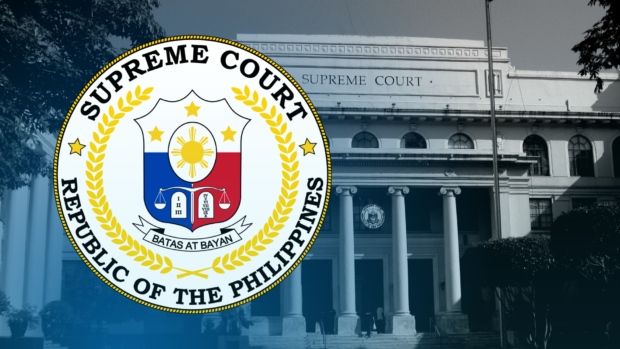
SUPREME COURT OF THE PHILIPPINES / STOCK
The Supreme Court has laid down the guidelines in the discernment process for crimes involving children in conflict with the law (CICL) as it affirmed the homicide charge against a then 17-year-old boy.
Discernment is the capacity of a child at the time of the commission of a crime to understand the difference between right and wrong and the consequences of the wrongful act.
Republic Act No. 9344, or the Juvenile Justice and Welfare Act of 2006, states that children 15 years of age and below are exempted from any criminal liability and those aged above 15 years old but below 18 years are also exempted unless they acted with discernment.
In a 26-page decision, the Supreme Court en banc denied the petition for review filed by the accused, challenging the decisions of the Court of Appeals (CA) and the Regional Trial Court of La Trinidad, Benguet, which found him guilty of homicide.
The high court pointed out that the level of education of the accused, identified in the decision as CICL XXX, who was then a second-year nursing student at the time of the incident, showed that he had the capacity to discern that inflicting bodily harm against the victim was wrong and would likely result in the latter’s death.
“As gleaned from these facts, he committed the crime with an understanding of its depravity and consequences. Thus, CICL XXX is criminally liable for his act,” the court said in a decision penned by Associate Justice Rodil Zalameda.
Timeline
Based on court records, around 3 a.m. on Oct. 28, 2003, the victim’s mother awakened from sleep after hearing someone shouting “Mama! Mama!”
After waking up her husband, they went outside and saw the victim lying on the front gate with his face and eyes bloodied.
When asked what happened, the victim told his parents that the accused and a companion were inside their house and “struck his eyes” after he asked why they were there.
After narrating the incident, the victim fell asleep and the next day, he complained of dizziness and one of his eyes was popping out.
Medical test results showed he suffered from severe brain damage and had “massive cerebral contusions and bleeding on spaces in the brain which may have been caused by any force or object hard enough to cause damage to the brain.”
He was discharged from the hospital in a “vegetative state” on Jan. 26, 2004, and after being bedridden for five years, the victim died on Nov. 26, 2008.
In his petition, the accused argued that there was a failure to seek proper and timely medical intervention, which could have saved the victim.
The accused also said that the narration of the victim could be considered as part of the “res gestae,” which refers to spontaneous statements made by the participants, victims or spectators of a crime immediately, before, during or after its commission.
According to the high tribunal, the testimony of the victim’s mother that pointed to the accused as the perpetrator “falls squarely under the res gestae exception to the hearsay rule.”
Guidelines
The high tribunal also sustained the CA ruling that the cause of the victim’s death was the brain injury caused by the force of the blow of the object used in hitting his head and not the failure of his parents to immediately seek medical help as claimed by the accused.
“The intent to kill is evident from the nature and location of the injury, conduct of the accused, and the circumstances under which the crime was committed,” the court said.
But since the victim was still a minor at the time of the incident, the Supreme Court noted the retroactive application of RA 9344.
This prompted the high court to issue guidelines in determining “discernment” in cases involving CICL.
According to the Supreme Court, the task of ascertaining discernment should be done initially by a social worker and finally by the court.
“The determination shall take into account the ability of a child to understand the moral and psychological components of criminal responsibility and the consequences of the wrongful act; and whether a child can be held responsible for essentially antisocial behavior,” it said.
‘Totality of facts’
There is no presumption that a minor acts with discernment, the high court said, adding that the prosecution is burdened to prove beyond reasonable doubt, by direct or circumstantial evidence, that he or she acted with discernment in committing the alleged crime.
In determining discernment, the high tribunal said courts must consider the “totality of facts and circumstances in each case,” including the “very appearance, the very attitude, the very comportment and behavior of said minor, not only before and during the commission of the act, but also after and even during trial.”
The courts must also take into account the gruesome nature of the crime, the minor’s “cunning and shrewdness,” the utterances, overt acts before, during and after the commission of the crime, the nature of the weapon used, and the minor’s attempt to silence a witness, and the disposal of evidence.
The Supreme Court sentenced the accused to an indeterminate penalty of six months and one day in prison as minimum and to eight years and one day imprisonment as maximum.
He was also ordered to pay the heirs of the victim a total of P604,145.01 for actual damages, civil indemnity and moral damages.
The case was also remanded to the CA to determine where the accused would serve his sentence following the provision of RA 9344, indicating that instead of the regular penal institution, he may serve in an agricultural camp or other training facilities instead.

